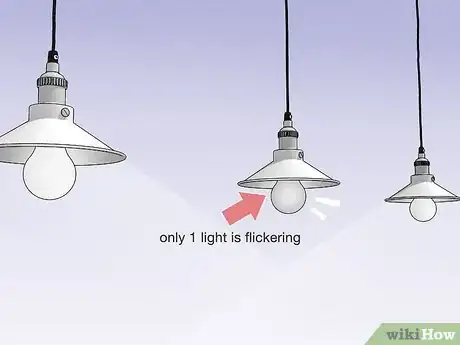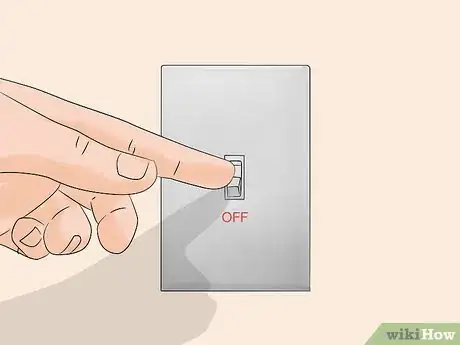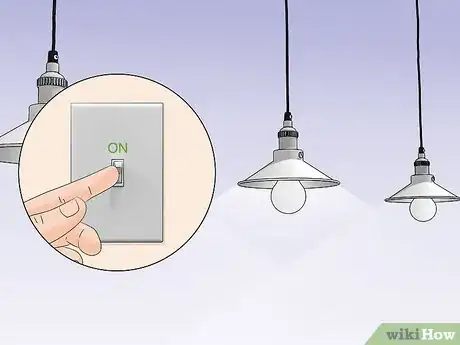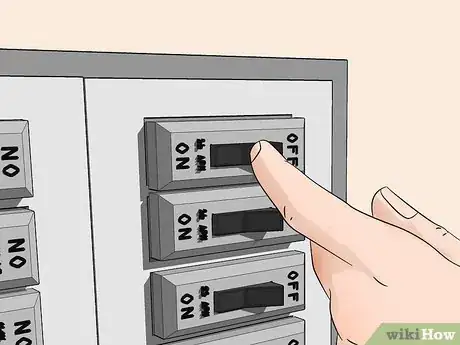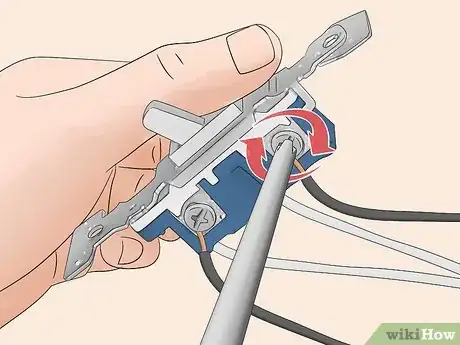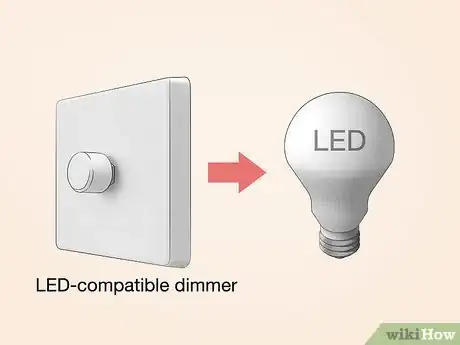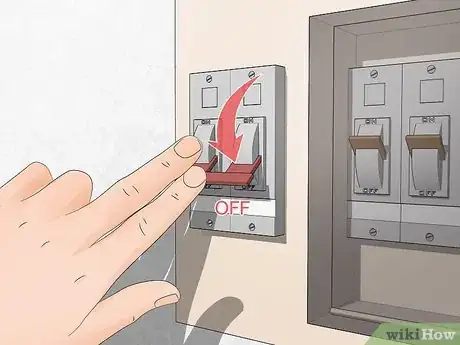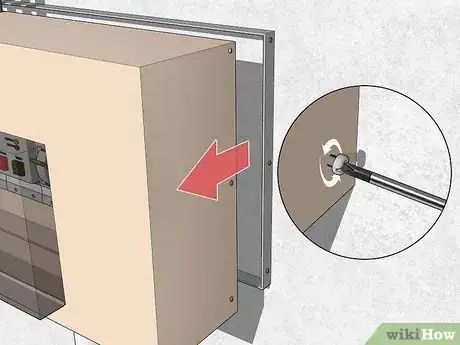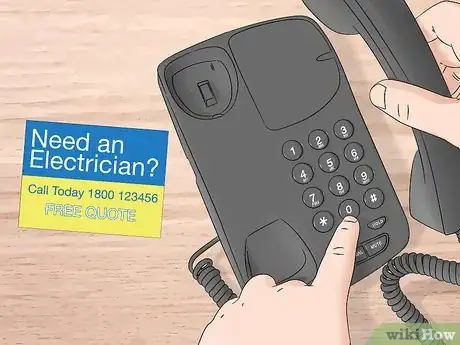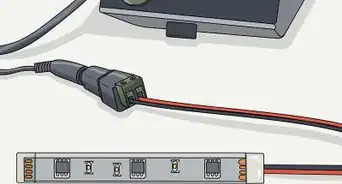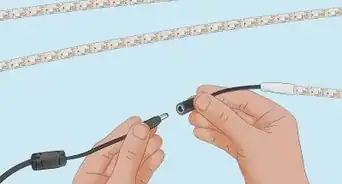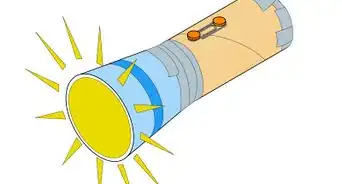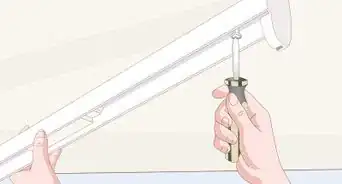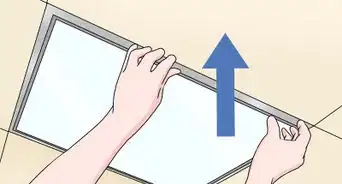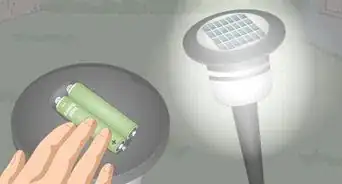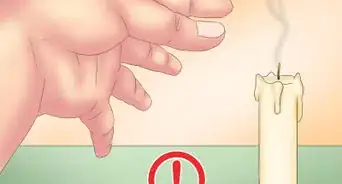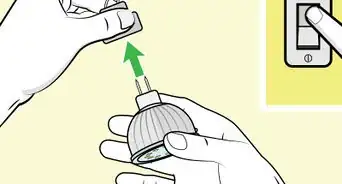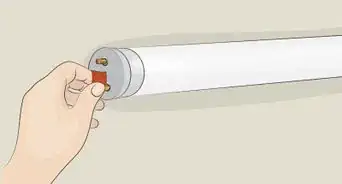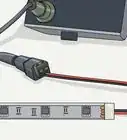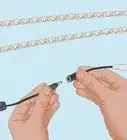This article was co-authored by Daniel Stoescu. Daniel Stoescu is a Master Electrician and the Owner and Operator of Home Tech Solutions, LLC in Hampton, Virginia. With over a decade of experience, Daniel specializes in wiring residential, commercial, and light industrial structures. The Home Tech Solutions team has over four decades of combined experience and offers comprehensive solutions for residential electrical needs.
There are 11 references cited in this article, which can be found at the bottom of the page.
This article has been viewed 41,165 times.
Flickering lights are a common problem. The cause can range from a loose bulb to faulty wiring. If your lights are flickering, first check if your bulbs are loose and tighten them up to see if that solves the problem. Then tighten the wiring in your light switches. Finally, make sure the screws in your breaker box are tight and see if this fixes your problem. If your lights continue flickering, contact a professional electrician for a full assessment.
Steps
Tightening the Lightbulbs
-
1Note that the problem is probably the bulb if only one light is flickering. When lights start flickering, the first question is whether the problem is from your wiring or the lightbulb itself. Wiring problems would affect multiple fixtures and maybe even the whole building. Check the other lights in your home. If only one or two are flickering, then the problem is probably not with your home’s wiring.[1]
-
2Turn off the flickering light and let it cool down before touching it. Whether the flickering light is on a fixture or appliance, start by turning the switch off. Then wait a few minutes for the bulb to cool down so you don’t burn yourself.[2]
- If you don’t want to wait for the bulb to cool, you could wrap a towel or oven mitt around your hand to protect it from the heat.
- Never try to adjust electrical appliances while the power is on. Always turn the power off first.
Advertisement -
3Tighten the bulb so it fits snugly in the socket. A loose lightbulb flickers because it forms an incomplete circuit with the electrical socket.[3] Tightening the bulb should fix this problem. Turn the bulb clockwise to tighten it.[4]
- Stop turning the bulb when it won’t go any further. Overtightening can damage the socket or even crack the bulb. You could cut yourself if the bulb breaks in your hand.
- Some lightbulb sockets spin along with the bulb, so you need two hands to tighten it. Hold the socket with one hand to keep it still while you turn the bulb with the other hand.
-
4Turn the lights back on to see if they’ve stopped flickering. If the lights were flickering because the bulb was loose, then the problem should be fixed when you turn the lights back on. If the flickering continues, the problem is probably with the light switch or your home’s wiring.[5]
Fixing the Connection in Your Light Switches
-
1Jiggle the light switch to see if the lights flicker. Sometimes the flickering is from a loose connection in your light switches.[6] This is especially common if you have a dimmer on the switch. Test your light switches by jiggling the knob. If the lights flicker while you do this, you probably have a loose connection in the switch.[7]
- Slowly raise the dimmer up and down as well. See if the lights dim and brighten consistently, or if there are quick jumps in brightness.
-
2Turn off the power to this room to prevent injuries. Before adjusting the connection in your light switch, make sure the power is turned off in this room.[8] Go to your breaker box and find the circuit breaker that powers the room you’re working in. Turn it to the Off position to cut the power to the room.[9]
- Test the switches in the room to make sure the power is off.
- Note that in this method you'll be working with wires. If you aren't confident in your ability to work with electricity, call a professional electrician.
-
3Unscrew the wall plate and light switch to expose the wires. There are 4 screws holding the light fixture to the wall. The first 2 secure the wall plate over the fixture. Remove them and take off the plate. Then remove the next 2 that hold the fixture itself to the wall.[10]
- Use a flathead screwdriver for this step. Since you're working with wires, use a screwdriver with a rubber handle.
- Keep track of all the screws you remove so you can replace them when you're done.
-
4Tighten the screws connecting the wires to the switch. Gently pull the fixture out of the wall. You’ll see wires secured to the light fixture with screws. Take your screwdriver and tighten each screw so it's snug.[11]
- Don’t overtighten the screws. Some might be tight enough and don’t need an adjustment. Don’t push the screws further if they stop spinning easily.
-
5Install an LED-compatible dimmer if you have LED bulbs. Flickering is common when LED lights don’t have an LED-compatible dimmer. If you use a dimmer and LED bulbs, your dimmer may not be LED-compatible. If your dimmer is already installed, you probably can’t tell just by sight if it’s designed for LED use. Try looking at the model number on the dimmer and doing an internet search for it. If you can’t find any information, contact the manufacturer and ask.[12]
- Change the dimmer switch to an LED-compatible one to fix the flickering problem.
- When buying a new dimmer, look at the packaging for text indicating that it is LED-compatible. If you aren’t sure, ask a store employee for help.
Checking the Wiring in Your Fuse Box
-
1Find your breaker box to check the wiring. If the lights are flickering in multiple rooms or appliances, then the problem is probably in your home’s wiring. A common cause is one or more screws in your circuit breaker box loosening over time. This causes an incomplete connection. Start by finding your breaker box to check its wiring.[13]
-
2Switch off the main breaker in your fuse box to prevent electrocution. Never work on your fuse box with the power connected. Switch off the main breaker first.[14] The main breaker is a larger switch than all the other circuit breakers. It is usually in the middle or on the top of the breaker panel. Switch it to the Off position before proceeding.[15]
- Note that this will cut power for your whole home. Turn off any appliances and make sure no one needs the electricity before you do this. Have a flashlight or battery-powdered lamp with you so you can see what you’re doing.
- To confirm the power is off, use a voltage tester to make sure there is no electric current in the breaker box.
- If you're unfamiliar with working on wires and electrical panels, call a professional electrician for this job.
-
3Remove the housing around the breaker panel. The metal housing around the breaker panel covers the panel’s internal wiring. Remove the screws holding the panel down. There will probably be 4 or 6 screws, depending on how the panel was installed. Then carefully lift the housing off when all the screws are removed.[16]
- Use a flathead screwdriver with a rubber handle for this step.
- Keep track of all the screws you remove so you can put them back when you’re done.
-
4Tighten all the screws connecting wires to the circuit breakers. If you look at the ends of the circuit breakers, you’ll see that each one has a wire running into it. Near where the wire enters the breaker is a screw that holds the wire in place. If this screw is loose, it could cause flickering lights. Work your way down the breaker panel and tighten every screw. Use a flathead screwdriver and turn the screws clockwise.[17]
- Many of the screws might not tighten easily. This means they are already tight enough, so don’t force them. You only have to tighten screws that have loosened up over time.
-
5Replace the breaker panel after you’ve tightened all the screws. Pick up the breaker panel and hold it up to the fuse box. Line up the screw holes in the panel with the ones on the box. Then hold the panel against the box and insert each screw.[18]
- Turn each screw by hand as much as you can so the panel remains stable. Then you can stop holding it up and tighten each screw with a screwdriver.
-
6Call an electrician if your lights are still flickering. If none of these troubleshooting methods work and your lights continue flickering, there may be more wiring problems in your home. These require professional assessment.[19] Contact an electrician to inspect your home and find the root of the problem.[20]
- Don’t ignore potential electrical problems in your home. Faulty wiring can cause a fire. Don’t delay in bringing in a professional.
Expert Q&A
-
QuestionWhat would cause lights to flicker?
 Daniel StoescuDaniel Stoescu is a Master Electrician and the Owner and Operator of Home Tech Solutions, LLC in Hampton, Virginia. With over a decade of experience, Daniel specializes in wiring residential, commercial, and light industrial structures. The Home Tech Solutions team has over four decades of combined experience and offers comprehensive solutions for residential electrical needs.
Daniel StoescuDaniel Stoescu is a Master Electrician and the Owner and Operator of Home Tech Solutions, LLC in Hampton, Virginia. With over a decade of experience, Daniel specializes in wiring residential, commercial, and light industrial structures. The Home Tech Solutions team has over four decades of combined experience and offers comprehensive solutions for residential electrical needs.
Master Electrician Loose connections, bad switches, faulty ballasts, and bad bulbs can cause flickering lights. You can find loose connections anywhere from the meter socket to the light switch.
Loose connections, bad switches, faulty ballasts, and bad bulbs can cause flickering lights. You can find loose connections anywhere from the meter socket to the light switch.
Warnings
- If you’re not comfortable with your ability to work with electricity, call an electrician. Electricity is very dangerous and you could injure yourself or cause a fire if you make a mistake.⧼thumbs_response⧽
- Wear rubber gloves and use tools with rubber handles when working with electricity.⧼thumbs_response⧽
- Always make sure the power is off before working on electrical outlets or switches.⧼thumbs_response⧽
References
- ↑ https://www.cnet.com/how-to/flickering-lights-check-these-common-culprits-first/
- ↑ https://www.cnet.com/how-to/flickering-lights-check-these-common-culprits-first/
- ↑ Daniel Stoescu. Master Electrician. Expert Interview. 21 June 2021.
- ↑ https://www.cnet.com/how-to/flickering-lights-check-these-common-culprits-first/
- ↑ https://www.bobvila.com/articles/flickering-lights/
- ↑ Daniel Stoescu. Master Electrician. Expert Interview. 21 June 2021.
- ↑ https://www.bobvila.com/articles/flickering-lights/
- ↑ Daniel Stoescu. Master Electrician. Expert Interview. 21 June 2021.
- ↑ https://youtu.be/ZmNpV0cACLQ?t=14
- ↑ https://youtu.be/ZmNpV0cACLQ?t=25
- ↑ https://youtu.be/ZmNpV0cACLQ?t=67
- ↑ https://www.washingtonpost.com/business/2018/07/25/how-stop-your-led-lights-flickering/
- ↑ https://www.cnet.com/how-to/flickering-lights-check-these-common-culprits-first/
- ↑ Daniel Stoescu. Master Electrician. Expert Interview. 21 June 2021.
- ↑ https://youtu.be/atPvvDDE4OM?t=29
- ↑ https://youtu.be/atPvvDDE4OM?t=35
- ↑ https://youtu.be/atPvvDDE4OM?t=75
- ↑ https://youtu.be/atPvvDDE4OM?t=169
- ↑ Daniel Stoescu. Master Electrician. Expert Interview. 21 June 2021.
- ↑ https://www.bobvila.com/articles/flickering-lights/
